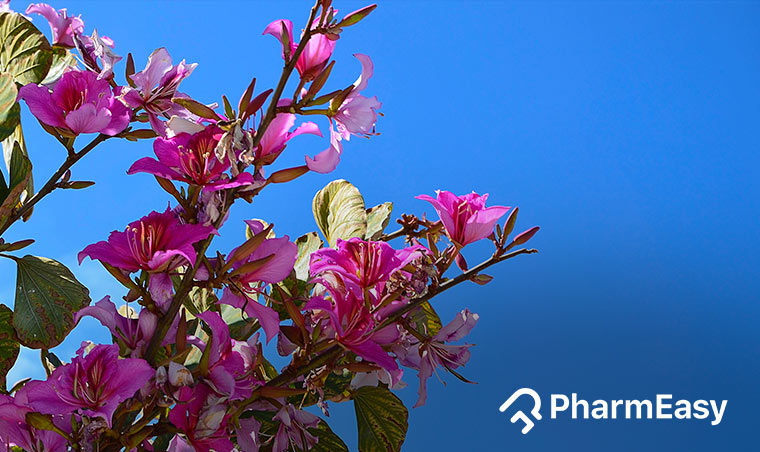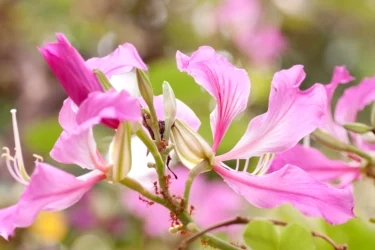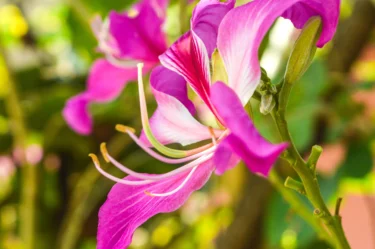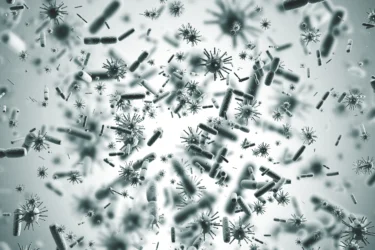Kachnar (Bauhinia Variegata): Uses, Benefits, Nutritional Value & More!
By Dr Siddharth Gupta +2 more

Get,

to manage your symptom
Get your,


4 Cr+ families
benefitted

OTP sent to 9988776655



You’ve successfully subscribed to receive
doctor-approved tips on
Whatsapp

Get ready to feel your best.

Hi There,
Download the PharmEasy App now!!


Register to Avail the Offer
Send OTPBy continuing, you agree with our Privacy Policy and Terms and Conditions

Hi There,
Sign up on PharmEasy now!!
Trusted by 4 crore+ families

OTP sent to 9988776655



You have unlocked 25% off on medicines




Code: NU25
By Dr Siddharth Gupta +2 more
Table of Contents
Bauhinia variegate (botanical name) is called Kachnar in Hindi. It has several other names: Orchid tree, Kanchan tree, Mountain ebony, Kaanchana, Bauhinia, Swet-kanchan, Camel’s foot, Kachnal, Gurial and Koiralo. The term Kachnar in Sanskrit means a beautiful glowing lady1. Kachnar is a member of the Fabaceae family. Kachnar is native to Southeast Asia and grows in tropical and subtropical climates. It is distributed in the sub-Himalayan and outer Himalayan regions of Sikkim and Punjab state (India). It is also found in other countries like China and Burma and tropical countries like South America and Africa. For several years, parts of the tree, including leaves, flowers, and flower buds are used as vegetables in several regions of India. Also the stem of kachnar produces fibre. Kachnar is also found to produce a kind of gum2.

Kachnar has the following nutritional value:
Kachnar tree has several biological properties, in one or the other form, which include:
There are several potential uses of kachnar are as follows:

Kachnar was found to reduce the elevated blood sugar level when its extract was given to rats. In studies it was found that kachnar contains a domain structure with the same amino acid sequence as insulin. The studies related to bauhinia variegata benefits in humans are insufficient. Before using kachnar for these properties for diabetic conditions, make sure you consult your healthcare provider and get a proper diagnosis and treatment. Avoid using kachnar or any other herb as medicine without consulting your physician.

Kachnar was reported to show anti-inflammatory and analgesic activity. It was found to have a new triterpene saponin (compound 9) in its leaves that decreases oedema, followed by a significant decrease in prostaglandin E2 (PGE2) levels in granuloma, liver homogenate, and serum. In addition, in a study the decrease in the diameter of pulmonary and hepatic granuloma was found after treatment with the compound, which can be due to its anti-inflammatory activity. It also shows analgesic effects in central and visceral nociceptive mouse models. This may indicate that kachnar may have some anti-inflammatory effect but these effects on humans will need further studies. You must consult a qualified doctor for better advice.
I recommend Kachnar may be used to aid in skin conditions, asthma, sore throats, diarrhoea, and stomach pain as a result of its antioxidant and anti-bacterial properties7.
Dr. Siddharth Gupta, B.A.M.S, M.D (Ayu)

The extracts of kachnar have shown significant antioxidant activity in studies5. The presence of phytoconstituents in kachnar like β-sitosterol and oleic acid have been known to decrease hyperlipidaemic states2. There are more studies required to establish the effect of the extracts on humans.
I recently read an article that suggests Kachnar may be used to aid depression. Kachnar has anti-oxidant properties and rich source of Vitamins and minerals, making it a potential ally for aiding depression.
Dr. Rajeev Singh, BAMS

Studies show that the extracts of the root and stem bark of kachnar effectively decreased the lipoprotein and plasma lipids levels in a rat model. It may be able to lower the low-density lipoprotein (LDL), very-low-density lipoprotein (VLDL), cholesterol, and triglyceride and increased high-density lipoprotein (HDL) levels. These studies are insufficient to show exact benefits of kachnar on humans.

The studies show that the extract of the stem bark of kachnar exhibits immunomodulatory activity on the primary and secondary antibody response by humoral antibody response for particular immune responses. The studies are insufficient to establish the impact of kachnar in humans.

The aqueous and ethanolic extract of the stem of the kachnar has shown antitumour activity in the mice model. There is a need of more extensive research to validate the effect of kachnar in humans.

The ethanolic extract of the stem of kachnar was given to rats, which attenuated various biochemical and histological symptoms of cisplatin nephrotoxicity this resulted in decreased urea and creatinine serum level and increased body weight and urine output. The nephroprotective benefits of kachnar are yet to be studied in humans extensively. You must consult a qualified doctor for better advice.

In a study the ethanolic extract of the stem of kachnar exhibited anti-ulcer activity. It decreased the total and free acidity, the volume of gastric secretion, and ulcer index in the rat model. We need further studies to estimate the impact of kachnar on humans. It is advisable to consult a qualified doctor for serious conditions.

Kachnar may have potential neural activity. The inhibition of acetylcholinesterase activity was found through thin layer chromatography (TLC). Further research may be needed to find the benefits for humans.

In studies the leaf extract of kachnar was found to inhibit bacterial growth. Its anti-microbial spectrum is relatively narrow. Sensitive organisms are Pseudomonas species, E. coli, Klebsiella pneumonia. Therefore, the extract may have potential effects against these bacteria. In other studies the bark powder of kachnar shows bio-enhancing, anti-bacterial, anti-inflammatory properties. Thus kachnar may have anti-microbial potential.

The methanolic extract of the stem bark of kachnar was reported to exhibit anticarcinogenic activity in the mice model. The protein obtained from the crude seeds of kachnar has haemagglutinating activity and is used for detecting the presence of viral particles2. The aqueous and ethanolic extract of the stem bark of kachnar increases the haemoglobin content of blood in rats2.
Though various studies show the potential uses of kachnar in various conditions, these are insufficient and there is a need for further studies to establish the true extent of benefits of kachnar on human health.
The traditional uses of kachnar as food are as follows:
You must consult a qualified doctor before taking any herbal supplements. Do not discontinue or replace an ongoing treatment of modern medicine with an ayurvedic herbal preparation without consulting a qualified doctor.
Also Read: Akarkara (Pellitory): Uses, Benefits, Side Effects & More!
Kachnar or Bauhinia variegata, shows promise for various health benefits. Its parts have been studied for effects like anti-diabetic, anti-inflammatory and antioxidant properties. However, more research is needed for conclusive results. As a culinary ingredient, Kachnar adds nutrition and potential wellness benefits to traditional dishes. Consultation with medical professionals is vital before including it in your routine.
As there are no reported side effects of kachnar, it can be considered safe.
It is advisable to consult an Ayurvedic physician before taking any herb. Moreover, if you experience any discomfort or allergic reactions after using kachnar, stop using and contact your healthcare provider immediately.
The woody part of the tree is utilised as fuel. The stem of kachnar produces fibre. Its wood is used to make several agricultural equipment and machines, and it is also found to produce gums2.
Yes, the flower of kachnar is edible and in many regions, it is used in curries, for making pakoras, in pickles, raita, as a vegetable, for flavouring of meat and fish.
Studies have shown anti-ulcer properties and decreases the total and free acidity and gastric secretion in the stomach that might be helpful. However, the extent in which kachnar may help human conditions.
There is no such evidence of the effect of its consumption during pregnancy; therefore, you should ask your doctor before consuming it.
There is no such evidence of the effect of its consumption during breastfeeding, so you should ask your doctor before consuming it.
There is evidence of use of kachnar as an antidote against snake bites found in traditions6. Since there is not sufficient scientific evidence for this claim you must see a doctor in emergency in such cases.
Disclaimer:The information provided here is for educational/awareness purposes only and is not intended to be a substitute for medical treatment by a healthcare professional and should not be relied upon to diagnose or treat any medical condition. The reader should consult a registered medical practitioner to determine the appropriateness of the information and before consuming any medication. PharmEasy does not provide any guarantee or warranty (express or implied) regarding the accuracy, adequacy, completeness, legality, reliability or usefulness of the information; and disclaims any liability arising thereof.
Links and product recommendations in the information provided here are advertisements of third-party products available on the website. PharmEasy does not make any representation on the accuracy or suitability of such products/services. Advertisements do not influence the editorial decisions or content. The information in this blog is subject to change without notice. The authors and administrators reserve the right to modify, add, or remove content without notification. It is your responsibility to review this disclaimer regularly for any changes.
Comments

Leave your comment...
You may also like
Comments